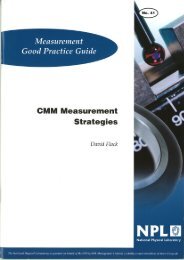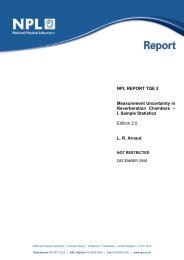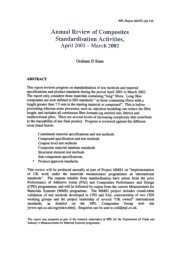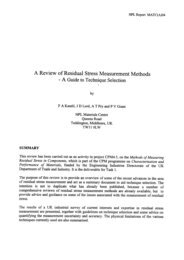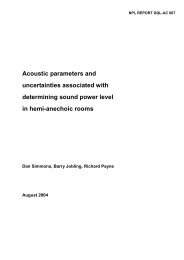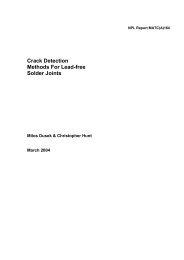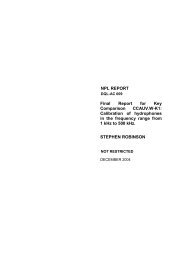Dimensional Measurement using Vision Systems - NPL Publications ...
Dimensional Measurement using Vision Systems - NPL Publications ...
Dimensional Measurement using Vision Systems - NPL Publications ...
Create successful ePaper yourself
Turn your PDF publications into a flip-book with our unique Google optimized e-Paper software.
<strong>Measurement</strong> Good Practice Guide No. 39<br />
development of high-resolution cameras with active areas containing more than 1,000,000<br />
pixels. These types of cameras can be employed to cover large fields of view, whilst still<br />
achieving high accuracy.<br />
The CCD active area is normally sensitive to wavelengths of light from around 400 nm to<br />
1000 nm (visible to infrared wavelengths). In general, the camera can discern between 256<br />
graduations (8-bits per pixel) of contrast information called grey scale, in addition to<br />
planar image information. More recent developments have seen the introduction of 10 and<br />
12-bit greyscale cameras, although for dimensional measurement 8-bit cameras are<br />
normally more than adequate. Most modern CCD cameras are capable of outputting the<br />
pixel clock, providing synchronisation between it and the frame grabber. They usually<br />
also provide other features such as Automatic Gain Control (AGC)*, which adjusts the<br />
sensitivity of the CCD sensors to match the image brightness and an electronic shutter,<br />
which allows selection of the exposure time of the CCD array.<br />
*Note: AGC should never be used when performing dimensional measurement as it may cause<br />
variations in the image intensity levels.<br />
5.1 LINEARITY<br />
When choosing a camera it is worth investigating the linearity of its sensitivity response.<br />
This is particularly important if the application involves imaging over a wide brightness<br />
range. In such cases it is advisable to check the linearity of the camera’s response with<br />
neutral density filters or a calibrated step wedge.<br />
5.2 DATA TRANSMISSION<br />
Analogue CCD cameras use the American RS-170, or the European CCIR video standards.<br />
The cameras output a voltage signal that corresponds to the brightness level of individual<br />
pixels. Both standards use 0-700 mV for the output signal, 0 mV being black and 700 mV<br />
white. The full frame transmission rates are slightly different, with RS-170 at 30 frames per<br />
second and CCIR at 25 frames per second.<br />
Digital cameras, by their discrete nature, require their own separate video standards, RS-<br />
422 and RS-644, which is the LVDS (Low Voltage Differential Signalling) format of RS-422.<br />
They offer data transmission rates of up to 400 MB per second. The main drawback to<br />
these standards is the requirement for bulky and inflexible cables for the data<br />
transmission. Added to this is a lack of inter-changeability between cameras and frame<br />
grabbers, which often results in very expensive, bespoke cabling solutions.<br />
43





